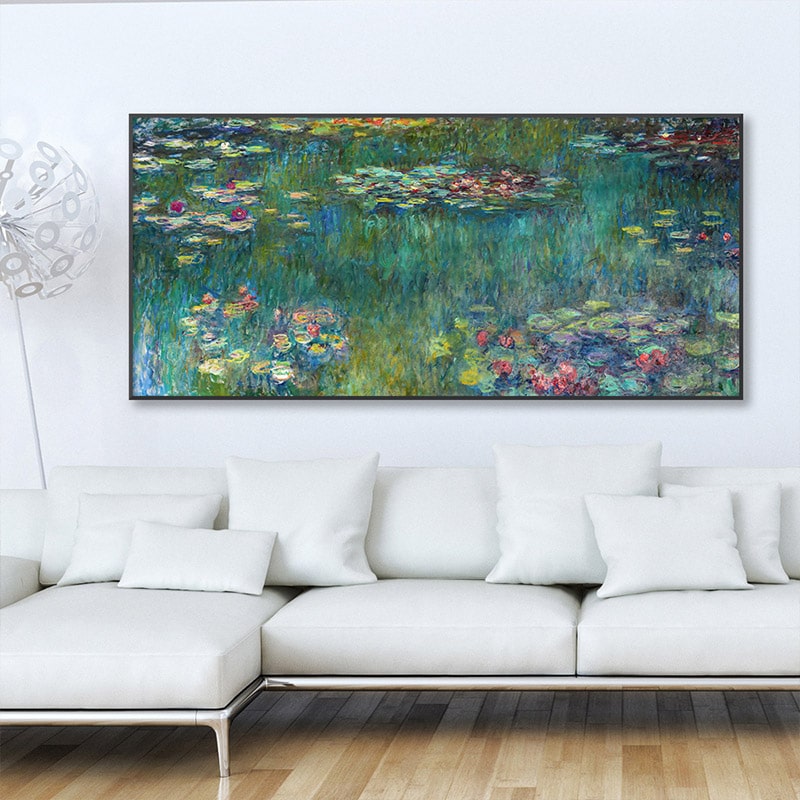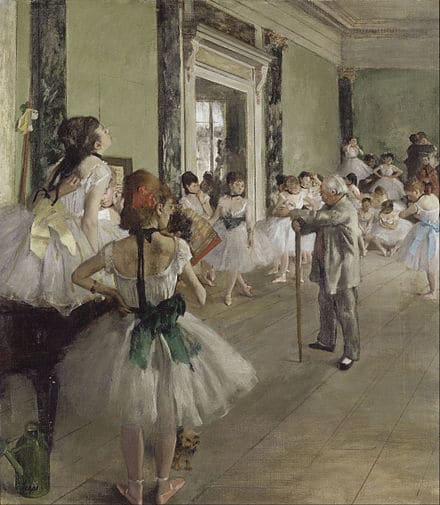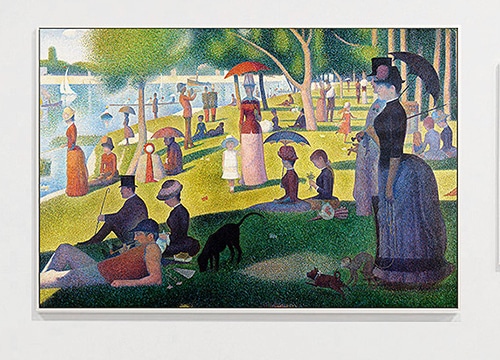- Impressionism Art Style – Shocking the Parisian Society
- Impressionist Period: The first Exhibition and Reactions
- Why we love the Impressionist Art Style Today
- The Science of Color and Light in Impressionism
- Three most famous Impressionist paintings and the artists behind them
- How to Style Your Space with Impressionist Art
- Conclusion
- FAQ
Today, nobody questions the legitimacy of the famous impressionist paintings, but when first exhibited in 1874, they were regarded as unfinished, slapdash, and even renegade. What remains of their power and why do we love to have them hanging in our homes?

Impressionism Art Style – Shocking the Parisian Society
Unlike the studio-based approach that held sway at the annual Salons of the French Royal Academy whereby tonal gradations were gradually built up with layer upon layer, Impressionist paintings were oftentimes fully completed outdoors ‘en plein air’. However, landscapes and images from contemporary, everyday life were considered less important in the eyes of the Royal Academy, where ancient Greek and Roman art, historical mythological, and religious themes were more appreciated. According to the Salon, figures had to be strongly defined and arranged in harmonious compositions – a rule, that the Impressionists deliberately broke.
Impressionist Period: The first Exhibition and Reactions
“Is the absence of rules a good thing? Only the future will enlighten us…” (Emilie Cardon).
Review on the occasion of the first impressionist exhibition in 1874
The famous Impressionist painters who participated in the first Impressionist exhibition in 1874, tired of having their work rejected by the Salon, called themselves the Anonymous Society of Painters, Sculptors, and Printmakers. In their exhibition, there was neither a hierarchy of subject matter, state involvement, and jury, nor were they sharing a mission. Notwithstanding, most of the artists involved were painting scenes from modern lives, landscapes, and cityscapes, using wide palettes of colours, broken brushstrokes, and loosely defined forms, that gave the paintings the air of spontaneity.
They often showed city folks in the latest fashions or enjoying leisure activities in the Paris suburbs, unafraid to also show the new way of life, including the increased industrialization around them. Impressionists were obsessed with capturing the ephemeral effects of light, dappled, and filtered by trees, broken by clouds, or as reflections on the water. The Impressionism art style juxtaposed vivid complementary colours and bright pigments, that had recently become available, to paint objects as they appeared to be.
Art critic Louis Leory ridiculed the title of one of Claude Monet’s paintings on display “Impression Sunrise”, saying that it was only an impression and an unfinished sketch unsuitable for display. He named the show the “Exhibition of Impressionists” which was meant as an insult. However, the critic Jules Castagnary later put this name in a positive light, saying that “It is lively, brisk, light – captivating. What a rapid grasp of the object and what an amusing facture. It is summary, agreed, but how spot on the marks are!”
The members of the Impressionist artists group fluctuated with each exhibition. By 1886, Impressionism had become a global movement, with artists around the world exploring similar techniques, subject matter, and style. The Impressionist era became the foundation for post-impressionists and many other modernists movements to come.

Why we love the Impressionist Art Style Today
Impressionist artist were able to capture the world through their very own lenses. When looking at their pictures, you are aware of the person standing in front of the canvas, applying the paint mark by mark, from their own viewpoint in a very personal manner. It is here that we can see the beginnings of the prominence of the individual which has since taken hold and that is most exemplified today in our digital society, our thirst to share everyday views of the world from out personal angles in our own ways. It is this singular, subjective vision that Impressionism has come to embody.
The Impressionist art style is neither violent, distressing nor sentimental or moralistic. It is not dark and dramatic like the art that preceded it, nor is it confounding like some of the art that followed it. It simply is pleasant to look at with its recognizable subject matter rendered in a lively, invigorating way. The pictures are a visual delight, opening a window to an enthralling moment in time.
Impressionism was one of the first avant-garde art movements, each rejecting tradition and embracing the modern, promoting new ideas about what could be achieved by creating art. This vibe is present in every one of the Impressionist images. Putting up such images transfers this pleasing drive of insurrection right into our living spaces.
Claude Monet, Pierre-Auguste Renoir, and Georges Seurat are three of the most famous Impressionist painters. In the following we further investigate details and notable works of the Impressionist era.
The Science of Color and Light in Impressionism
Impressionist painters completely transformed the use of color and light in art, offering a more spontaneous and emotional approach than previous movements. By using vibrant, unmixed colors and quick brushstrokes, they captured fleeting moments of light and atmosphere, particularly in outdoor settings. The effect is both dynamic and soothing, as the viewer is invited to experience how the natural world changes with light throughout the day.
Modern color theory supports the psychological impact these works have on viewers. Bright, warm hues like those found in Monet’s Impression, Sunrise or Pissarro’s landscape scenes evoke feelings of joy, energy, and vibrancy, while cooler tones in works such as Degas’ ballet scenes can create a sense of calm and relaxation. This interplay of color and light doesn’t just depict nature but invites an emotional connection, making Impressionist art ideal for home interiors that seek to evoke specific moods.
Incorporating an Impressionist painting into your space means more than adding art to the walls—it adds depth, energy, and movement to the room. The paintings capture different times of day, light conditions, and seasons, keeping your room feeling fresh and alive. This use of color and light enhances natural light in your home, making rooms feel more expansive and bright. Whether it’s the warm glow of a sunset or the soft coolness of a rainy morning, the science behind color and light in Impressionism can make any space feel welcoming and engaging.
Three most famous Impressionist paintings and the artists behind them
Claude Monet, Impression Sunrise

Claude Monet’s “Impression, Sunrise” was first shown at the first impressionist exhibition in 1874 and is credited to have inspired the name of the modernist art movement of Impressionism. Parisian art critiques faulted Monet’s painting technique for its unfinished appearance, the seemingly amateurish quality, for its light and loose brushwork, and his style of painting out of doors, en plein air.
In “Impression, Sunrise” Claude Monet depicts the port of Le Havre, his hometown in the Northwest of France. He most likely completed the picture in a single sitting on the spot, standing at a window overlooking the harbour at sunrise. It gives a suggestion of the early morning mist clogged with industrial smoke of the city. In his Impressionist landscape paintings, Monet stripped away the details to a bare minimum: the dockyards in the background are merely suggested by a few brushstrokes, as are the dark vessels which contrast against the hazy background, interspersed with orange and yellow hues of the red sun. More
Pierre-Auguste Renoir, Dance at Le Moulin de la Galette

French artist Pierre-Auguste Renoir is considered one of the leading painters in the development of the Impressionist style. In his pictures, he depicted the beauty and especially feminine sensuality. The painting “Dance at Le Moulin de la Galette” created 1876 is a seminal work of Renoir’s early maturity and widely celebrated as one of the important masterpieces of early Impressionism.
Capturing the vivacious and joyful atmosphere of the popular dance garden in Montmartre, Paris bathed in natural light was the artist’s main goal. Renoir chose an ordinary scene of the Parisians at leisure, during a typical Sunday afternoon at the Moulin de la Galette. In the late 19th century, working-class Parisians would dress up and enjoy spending time at this dance garden of Montmartre eating, drinking, and dancing till the evening. The “Dance the Le Moulin de la Galette” is a snapshot of real life, which is typical for the Impressionist art movement. It shows a richness in form, loose and fluid brushwork, capturing the flickering of the sun-dappled light. The personnel shown includes both regular patrons and some of Renoir’s preferred models.
The painting was Renoir’s most important work of the mid 1870’s and strongly influenced other avant-garde artists. More
Georges Seurat, A Sunday on La Grande Jatte

French artist Georges Seurat is one of the leading painters in the development of the post-Impressionist style. Today considered as his greatest work, “A Sunday Afternoon on the Island of la Grande Jatte” sparked public outrage and indignation due to the choice of the ‘vulgar’ topic and the artist’s mathematical and robotic interpretation of modernity in Paris. Notwithstanding, his style for which he tackled issues of form, colour, and light in an almost scientific manner, fascinated and inspired many fellow artists.
For Parisians, Sunday was the day to escape the summer heat of the city and seek the shade of the trees and the breeze of the River Seine. In his picture, Seurat shows the citizens relaxing in the suburban park on the island La Grande Jatte in the river. Among them are a fashionable dressed couple strolling across the lawn, to the left another well-dressed woman by the water, a small man with a black hat gazing at the river, a man playing the horn, and a woman knitting. Furthermore, there are two soldiers standing at attention and a man with a pipe and a couple with an infant child. Curiously, one lady is holding a monkey on a leash, a lady is fishing and another woman with a child staring directly at the viewer of the picture. More
These artists are considered the pioneers of Impressionism and Neo-Impressionism. Their works are timeless masterpieces and broke the conventions of art during the 19th Century. The question posed in the 1874 review of the first Impressionist exhibition “Is the absence of rules a good thing? Only the future will enlighten us…” can be clearly answered with: It does enlighten us, since it has demonstrated the spectrum of what the pursuit of singular vision can bring forth.
How to Style Your Space with Impressionist Art
Pairing Impressionist paintings with your interior design can elevate any space by bringing warmth, texture, and light. For modern minimalist spaces, a vibrant Monet or Renoir piece adds a pop of color and dynamic movement, creating balance against clean lines and simple furnishings. In more traditional or rustic spaces, the soft, natural tones and textured brushstrokes of an Impressionist landscape blend harmoniously with vintage or earth-toned decor.
You can also mix frame styles to complement your interior. For contemporary looks, opt for sleek, neutral frames that let the painting shine without overpowering the space. In contrast, ornate, classic frames work well in more traditional settings, adding elegance and depth.
Consider the room’s natural light when placing Impressionist art. Impressionist paintings often capture the beauty of light itself, so positioning them where they’ll catch sunlight enhances their glowing, luminous quality. Whether hung above a sofa, in a gallery wall, or as a statement piece, Impressionist works create a serene, uplifting atmosphere in any room.
Conclusion
Incorporating Impressionist art into your home offers more than just aesthetic value—it transforms the atmosphere, infusing your space with light, color, and movement. Whether you’re enhancing a minimalist room or adding to a traditional decor, these timeless pieces bring warmth and personality.
The unique techniques of Impressionism, like broken color and impasto, create depth and energy, making every glance a new experience. By carefully choosing placements and pairings, you can create a dynamic and inviting space that reflects both style and history.
FAQ
How do I choose the right Impressionist painting for my home? Consider the color scheme of your space when choosing an Impressionist painting. Opt for bright, vibrant pieces if you want to liven up a room, or choose softer hues to create a calming environment. The subject matter, such as landscapes or portraits, should also complement your existing decor style.
Can I combine Impressionist art with modern decor? Yes, Impressionist art can enhance modern decor by adding texture, color, and a sense of history. Pairing an abstract, minimalist room with a colorful Monet or Renoir introduces contrast and warmth. The key is to balance the dynamic energy of the artwork with clean, simple furniture to create harmony.
How does natural light affect the display of Impressionist paintings? Natural light can enhance the vibrancy and texture of Impressionist paintings, as these works often depict changing light conditions. Placing your painting near a window allows the sunlight to reflect off the brushstrokes, intensifying the colors. Avoid direct sunlight, however, as it may cause fading over time.
Should I frame my Impressionist painting? Framing can elevate the presentation of an Impressionist painting and protect it from damage. Choose frames that match your room’s decor; sleek, minimalist frames for modern interiors and ornate frames for traditional spaces. The right frame not only preserves the artwork but also enhances its visual impact.
How do Impressionist paintings influence the mood of a room? Impressionist paintings can dramatically affect a room’s ambiance. Pieces with bright, warm colors like those by Renoir or Sisley bring energy and joy, while cooler, softer tones from artists like Pissarro create a sense of calm. The fluidity and movement of the brushstrokes also give a dynamic, lively feeling to any space.
Can I mix different art styles with Impressionist works? Mixing art styles can create a unique and eclectic look in your home. Impressionist pieces pair well with both modern and traditional art, depending on how you balance them. For a cohesive design, focus on complementary colors or themes to link the different styles together.
What are the best rooms to display Impressionist paintings? Impressionist paintings work well in living rooms, dining rooms, and bedrooms, where they can become focal points. They add a calming presence to bedrooms and bring lively energy to social areas like living rooms. Choose the room based on how you want the painting’s mood and colors to interact with your decor.
How can I protect my Impressionist painting from damage? To protect an Impressionist painting, avoid placing it in direct sunlight or humid areas, as these can cause fading or warping. Consider using UV-protective glass if you frame the piece. Regular dusting with a soft cloth and keeping it away from high-traffic areas will also preserve its condition.
What should I consider when hanging an Impressionist painting? When hanging an Impressionist painting, think about its scale relative to the room and furniture. Larger works are best displayed on wide, open walls, while smaller pieces can be grouped for a gallery effect. Ensure the artwork is at eye level to maximize visual impact.
How do Impressionist paintings complement natural materials in decor? Impressionist paintings often depict natural elements like landscapes and water, making them an excellent match for interiors featuring natural materials. Wooden furniture, stone accents, and linen fabrics harmonize well with the organic feel of Impressionist art. The textures and colors in the painting enhance the warmth and earthiness of these materials.
You might also enjoy reading the following posts by Pigment Pool:
Difference between Impressionism and Post-Impressionism: Art History Insights
Mandala and Meaning: The History and Significance of Mandalas
Impressionists and Photography: How the Camera Changed Art Forever
